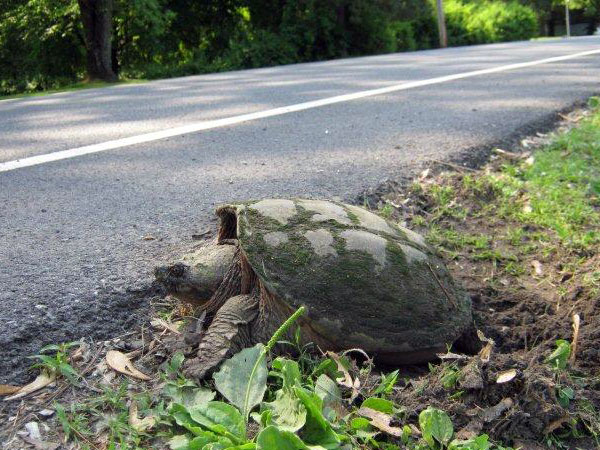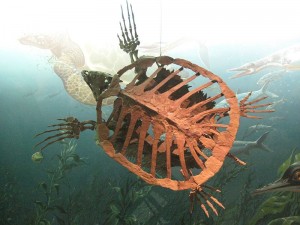I brake for dinosaurs
Physically, they haven’t changed much in 215 million years, but their world sure has — as far as we know ancient turtles didn’t have to dodge motor vehicles.

Snapping turtle laying eggs on Glenwood Avenue in Queensbury. Archive Photo of the Day: Stuart Delman, Chestertown, N.Y.
The modern snapping turtle has “only” been around for about 40 million years. From late May until early July when female snappers are out looking for places to dig a hole in which to deposit their leathery “Ping-Pong ball” eggs, you may see them egg-laying on sandy road shoulders or crossing the pavement. Sadly many such females, ranging in size from about eight pounds up to thirty or more, are killed by traffic.
Even more tragic is the fact that some motorists intentionally hit snapping turtles, which are unfairly blamed for killing off game fish and young waterfowl. Snappers are omnivores and feed on everything from aquatic vegetation to crayfish to carrion. During the height of summer the majority of their diet is plant-based. Despite decades of research from the 1950s to the present day that exonerates snapping turtles of all game-species murder charges, they are still seen as a threat to wildlife by those who fish and hunt. It’s not to say turtles won’t eat a trout or gosling, but in natural habitats they have no measurable impact on game species. Private ponds and other non-natural habitats are exceptions and can sometimes require turtle management.

This Protostega Gigas, a sea turtle from 70 million years ago, weighed up to two tons. At least it would have been an even match for your car. Photo: CLaire H., Creative Commons, some rights reserved
A turtle’s shell, composed of a carapace (top) and a plastron (bottom) is an extension its vertebrae, and is essentially living bone that’s covered in tissue similar in composition to our fingernails. Unfortunately the shell is not as strong as it looks, and even if a turtle appears unscathed after being hit by a car, chances are it has numerous broken bones and internal injuries.
You can help a turtle cross the road as long as you follow a few rules. First, be safe. Don’t stop if you’ll be in danger of getting hit or of causing a traffic accident. You don’t want to get other drivers killed, even if it is a turtle-hitter. Second, listen to the turtle. If she wants to get across the road, it doesn’t matter if you think conditions on the other side don’t look conducive to egg-laying. If you turn her back she’s just going to cross again.
“The safest way to handle a snapping turtle is to ask someone else to do it.”
The safest way to handle a snapping turtle is to ask someone else to do it. In the water they feel safe and are generally docile. Bites are extremely rare in water. On land, however, it is a different story. Because snappers can’t pull themselves inside their shells as completely as other turtles, they’ve developed “attitude” to compensate. Their unusually long necks can reach around nearly to their back legs to snap with their toothless — but sharp — beaks.
Picking up turtles by the tail may seem like a safe method, but this can damage their spines. The recommended “turtle hold” is to grasp the carapace on either side near the back end. Remember the part about them reaching back past the middle of their shells to bite? I carry a scoop shovel in the trunk for turtle-herding.
Because road-killed snapping turtles are nearly always fertile females, road mortality is a real threat to their species. Snappers become mature by size rather than age, and begin breeding when their shells measure about eight inches across. A large female can weigh 25-35 pounds and have a shell of 15”- 20” in diameter.
Turtle shells are segmented like a mosaic. Each section, known as a scute, has growth rings that correspond to age, similar to the annual rings of a tree. These rings are how we know snappers in the wild can live at least 70 years, and quite possibly longer, though the average age is closer to thirty.
Slowing down near wetlands during breeding season can help reduce turtle mortality. You’re most likely to see snapping turtles during June from dawn to midday, and again in the evening. Also, let’s help restore their reputation by spreading the word that they are not a danger to fish and waterfowl. We need to respect our elders, especially those that have been around longer than the dinosaurs.
Paul Hetzler is a horticulture and natural resources educator with Cornell Cooperative Extension of St. Lawrence County.
Tags: environment, nature, turtles








Frankly, to all of those who kill snappers or any other species because they view them as killing animals they want to kill or catch, maybe some hunters and/or fishermen might want to treat you as a competing predator worthy of being eliminated.
As to any animal crossing the road, including human animals, one should always give them time to cross the road.
To those who might want to help snappers get across the road, be careful how you pick them up and carry them across, and I’m not talking about trying not to get hit by a car or truck. I’m talking about how snappers will snap at you and are not often appreciative of your efforts to help them.
I usually have heavy leather gloves in the car, so I have given snappers a lift across the road without harm to either of us in the past. I also usually have a shovel in the car — just never thought of using it to help a snapper. I will put it to work this summer.
I found one laying eggs in a mulch pile years ago. I left that pile alone all summer to give them a chance to move on, and finally in September, I thought it was safe to go ahead with my plans. I was stunned to find eggs still intact though quite worn and dirty looking. I guessed that they must have failed, and opened one just to see. I was horrified to discover a tiny turtle, not quite ready to hatch so late in the year, and have always wondered…when DO they hatch anyway?? What does a half inch long turtle do in September or October?
Michael,
Snapping turtle eggs usually take between 80 and 90 days to hatch (potentially 55-120 days), so it’s not uncommon to find them hatching in September or October. They usually have an instinctive drive to head for a water body. Early last April I found several hatchlings which had apparently overwintered in some mulch. Supposedly this is rare, though.